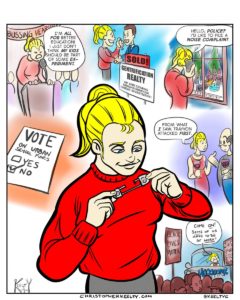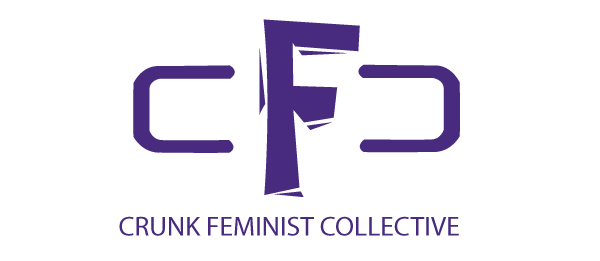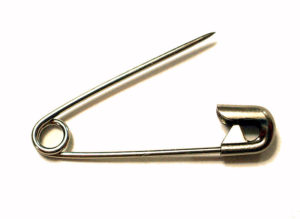When I first heard about the safety pin initiative, I was at a conference breaking bread with my favorite white woman in the world, telling her about my overall ambivalence and disillusionment with unknown white folk post-Trump election. Still in my feelings (and let’s be clear, I am and will be all up in my feelings for a long damn time), I felt duped by the façade of white progressivism and antiracism in a moment when my safety and the safety of all black and brown, undocumented and unchristian, non-gender conforming and non-heterosexual, intergenerational, poor, and working class activist, and intersectional, identity fluid, differently abled bodies of all colors and on all ends of the “spectrum” are vulnerable and at risk.
At first, I was relieved at the idea of a gesture of support and connection that would signal a white person was safe—especially once I returned to one of the two red states I call “home.” For the days since the election, I had been sharing space with white folk who were communicating their support, fears, rage and disappointment through swollen eyes, tear stained faces, participation in protests, generous hugs, and presence in rooms with marginalized folk of color listening and learning, deliberate about not taking up space and providing support in whatever ways were invited. I was insulated by like-minded white folk who are well-intentioned if not reflective, and critical if not conscious of the role of whiteness and white supremacy on the lives of marginalized people of color. I was in an echo chamber of like-minded individuals who fully recognize the implication of Trump(ism). I was initially comforted at the possibility that I would recognize them outside of our ad hoc space.
Later that night, I recalled a conversation during a social justice Teach-In I organized that took place on Wednesday, in the immediate aftermath and realization of our worst fears. A dear friend, a white woman social justice activist who commits both her work and her body to empowering young people to make and mark justice and change, challenged us to not see spaces like the one we were creating in a mid-sized room in a downtown hotel as “safe spaces” but “brave spaces.” This concept, borrowed from Brian Ama and Kristi Clemens’ chapter “From Safe Spaces to Brave Spaces: A New Way to Frame Dialogue Around Diversity and Social Justice” in the 2013 book, The Art of Effective Facilitation: Reflections from Social Justice Educators encourages a transition from discussing “safe space” to “brave space.” This concept, which has been critiqued for requiring “marginalized peoples to perform the labor of education,” helped those of us in the teach-in reckon with our fear even within a space that was relatively safe, and the bravery that would be required to continue social justice work in the hostile spaces outside. It also caused me to think about the difference between safety and bravery.
Truth is, white folk (especially white men) and straight folk, and upper class folk, and cisgendered folk are relatively “safe,” and not only from the rigorous and continuous public assaults and attacks from emboldened bigotry, but from the policies and laws and potential retrograde restrictions that could be put in place to put us (people of color, non-normative folk, and women) in our “respective” places. But folk of color and those who identify as LGBTQAI+, and those who are not middle or upper class, who don’t have job security, those who are trans or gender nonconforming, or otherwise labeled as “other” will never be safe— but they are inherently BRAVE. And the marking of their bravery is not a removable or symbolic object, it is their embodied identities, their resilience, their insistence on being, loving, embracing and defending themselves, with or without a safety pin, that makes them brave—but never safe.
So, I felt conflicted. My initial feelings of relief around safety pins marking white folk as safe was replaced with the reality that symbols have meaning, but they can also be intentional disguises or guises to hide one’s real intentions, thoughts or deep seated beliefs.
Because…pantsuits.
I am convinced, given the poll numbers and reports, that a large number of white women wore pantsuits to the polls to vote for Trump. Many of them too embarrassed to admit their “known all along” intention of supporting patriarchy and white supremacy closeted their private investment with public symbols that marked them as “safe.” They joined the Pantsuit Nation Facebook group, were publicly outraged at the President-Elect’s bigotry and misogyny, and then voted for him and against us, because it was not possible to vote against themselves.
Because… patriarchy and white privilege are powerful drugs, and white women are often protected from their complicit participation in both.
I was suddenly suspicious of safety pins.

I understand and appreciate the intention of expressing allyship. Symbolism (and words, despite seeming evidence to the contrary based on this year’s campaigns) matters, but in this moment it is insufficient. I think of the Safe Zone sticker on my office door at the University of Alabama and how it means nothing if LGBTQAI+ students don’t feel “safe” in my classroom. Fuck my office space, can they count on me to make the classroom safe for them? If white folk are passing out gestures of support and willingness to protect me, I want it to be communicated verbally, explicitly, because anybody can put on a safety pin while wearing a pantsuit to cover up their problematic politics. Instead of a safety pin, or hell alongside a safety pin, I’m going to need allies to speak up and speak out, and do some of the work that I am so often expected to do as a person of color and scholar-activist. CF Crunkadelic challenged white allies to “get your people” and I want to double down on that. Safety pins may make you feel better in this moment, but as a person of color I would prefer an act of solidarity that I can discern even if you forget to put on your pin in the morning.

